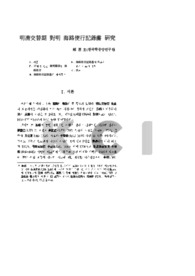

PARTNER
검증된 파트너 제휴사 자료
明淸交替期 對明 海路使行記錄畵 硏究 (Paintings of the Korean Envoys to Ming by Sea during the Ming-Qing Transition)
40 페이지
최초등록일 2025.04.30
최종저작일
2007.04

-
미리보기
서지정보
· 발행기관 : 명청사학회
· 수록지 정보 : 명청사연구 / 27호 / 189 ~ 228페이지
· 저자명 : 정은주
초록
After the deposition of Gwanghaegun(r.1608-1623) and Injo Restoration of 1623, Joseon was under the control of Ming more than ever. During the Ming-Qing Transition, the Korean envoys visited the Ming Court in Beijing by dangerous sea route to keep out of Liaodong(遼東) Later Jin(後金: 1616-1636) occupied. There are some paintings to substantiate that the Korean envoys went to Ming by sea route between Korea and China in the early 17th Century.
Paintings of the Korean envoys to Ming by Sea were painted to commemorate the envoys' fellowship and to hand down from generation to generation. Those paintings are related to Cheokhwapa(斥和派) such as Kim Sang-heon(1570-1652) and Hong Ik-han(1586-1637), the scholar-officials who had argued forcefully against making peace with Qing. Even though, their descendants reproduced those paintings. It proves that Korean scholar-officials how to understand Later Jin in the early 17th Century as well as how to maintain the reverence for Ming dynasty in the late Joseon period.
This paper deals with the humane and historical information of the Sino-Korean relations on the paintings depicting the main route Korean envoys went to Beijing in the early 17th Century.
The name of Seonsapo-port(旋槎浦) in Gwaksan on the paintings is originated from the great pleasure of Korean envoys who returned the port after their tribute mission. The name offers a clue to classify Yeonhaeng-dopok(燕行圖幅) type, painting is about the scene of Ambassador Yi Deok-hyeong along with other Korean envoys visiting the Ming Court in 1624 to request confirmation of the newly clowned King Injo, out of paintings at the time. Also we can find Gado-island(椵島) and Sapo-inlet(蛇浦) in Cheolsan, the Liaodong provincial governor-general Mao Wen-long(1576-1629) and his army stationed, on the paintings. Most of all, the paintings show us how Korean envoys were fear of the sea route to pass through. Its icon is similar to the ocean voyage pattern-copper mirror(煌丕昌天銘鏡) in Goryeo Dynasty.
Paintings of the Korean envoys to Ming by sea depicted the Korean envoys' procession including houses carried diplomatic document in Dengzhou(登州), Chinese first overland way after sea route, and Incense parade for Taisan Mountain God in Jinan(濟南). The parade was encouraged to increase the national income at the time. The map of Yanjing(燕京全圖) shows especially structure of the Ming palace (Forbidden City) in the early 17th Century. After all, Paintings of the Korean envoys to Ming by Sea reflect Sino-Korean relations during the Ming-Qing Transition via the historical sources and the geographical information by the Korean official envoys.영어초록
After the deposition of Gwanghaegun(r.1608-1623) and Injo Restoration of 1623, Joseon was under the control of Ming more than ever. During the Ming-Qing Transition, the Korean envoys visited the Ming Court in Beijing by dangerous sea route to keep out of Liaodong(遼東) Later Jin(後金: 1616-1636) occupied. There are some paintings to substantiate that the Korean envoys went to Ming by sea route between Korea and China in the early 17th Century.
Paintings of the Korean envoys to Ming by Sea were painted to commemorate the envoys' fellowship and to hand down from generation to generation. Those paintings are related to Cheokhwapa(斥和派) such as Kim Sang-heon(1570-1652) and Hong Ik-han(1586-1637), the scholar-officials who had argued forcefully against making peace with Qing. Even though, their descendants reproduced those paintings. It proves that Korean scholar-officials how to understand Later Jin in the early 17th Century as well as how to maintain the reverence for Ming dynasty in the late Joseon period.
This paper deals with the humane and historical information of the Sino-Korean relations on the paintings depicting the main route Korean envoys went to Beijing in the early 17th Century.
The name of Seonsapo-port(旋槎浦) in Gwaksan on the paintings is originated from the great pleasure of Korean envoys who returned the port after their tribute mission. The name offers a clue to classify Yeonhaeng-dopok(燕行圖幅) type, painting is about the scene of Ambassador Yi Deok-hyeong along with other Korean envoys visiting the Ming Court in 1624 to request confirmation of the newly clowned King Injo, out of paintings at the time. Also we can find Gado-island(椵島) and Sapo-inlet(蛇浦) in Cheolsan, the Liaodong provincial governor-general Mao Wen-long(1576-1629) and his army stationed, on the paintings. Most of all, the paintings show us how Korean envoys were fear of the sea route to pass through. Its icon is similar to the ocean voyage pattern-copper mirror(煌丕昌天銘鏡) in Goryeo Dynasty.
Paintings of the Korean envoys to Ming by sea depicted the Korean envoys' procession including houses carried diplomatic document in Dengzhou(登州), Chinese first overland way after sea route, and Incense parade for Taisan Mountain God in Jinan(濟南). The parade was encouraged to increase the national income at the time. The map of Yanjing(燕京全圖) shows especially structure of the Ming palace (Forbidden City) in the early 17th Century. After all, Paintings of the Korean envoys to Ming by Sea reflect Sino-Korean relations during the Ming-Qing Transition via the historical sources and the geographical information by the Korean official envoys.참고자료
· 없음태그
-
자주묻는질문의 답변을 확인해 주세요

꼭 알아주세요
-
자료의 정보 및 내용의 진실성에 대하여 해피캠퍼스는 보증하지 않으며, 해당 정보 및 게시물 저작권과 기타 법적 책임은 자료 등록자에게 있습니다.
자료 및 게시물 내용의 불법적 이용, 무단 전재∙배포는 금지되어 있습니다.
저작권침해, 명예훼손 등 분쟁 요소 발견 시 고객센터의 저작권침해 신고센터를 이용해 주시기 바랍니다. -
해피캠퍼스는 구매자와 판매자 모두가 만족하는 서비스가 되도록 노력하고 있으며, 아래의 4가지 자료환불 조건을 꼭 확인해주시기 바랍니다.
파일오류 중복자료 저작권 없음 설명과 실제 내용 불일치 파일의 다운로드가 제대로 되지 않거나 파일형식에 맞는 프로그램으로 정상 작동하지 않는 경우 다른 자료와 70% 이상 내용이 일치하는 경우 (중복임을 확인할 수 있는 근거 필요함) 인터넷의 다른 사이트, 연구기관, 학교, 서적 등의 자료를 도용한 경우 자료의 설명과 실제 자료의 내용이 일치하지 않는 경우
문서 초안을 생성해주는 EasyAI
